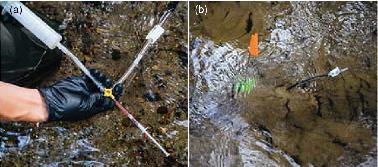当前位置:
X-MOL 学术
›
Groundwater
›
论文详情
Our official English website, www.x-mol.net, welcomes your
feedback! (Note: you will need to create a separate account there.)
A Dye Tracer Approach for Quantifying Fluid and Solute Flux Across the Sediment–Water Interface
Ground Water ( IF 2.0 ) Pub Date : 2020-12-06 , DOI: 10.1111/gwat.13060 Ryan N. Cascarano 1 , Donald M. Reeves , Mark A. Henry 2
Ground Water ( IF 2.0 ) Pub Date : 2020-12-06 , DOI: 10.1111/gwat.13060 Ryan N. Cascarano 1 , Donald M. Reeves , Mark A. Henry 2
Affiliation

|
We propose a dye tracer method to characterize fluid and solute fluxes across the sediment‐water interface. Zones of groundwater discharge within the streambed are first identified, and small volume slugs of 0.5 to 1 mL fluorescein dye are released at known subsurface depths. Fluorescein dye allows for visual identification of interface breakthrough locations and times, and dye concentrations at the point of discharge are recorded over time by a fluorometer to generate high resolution breakthrough curves. Groundwater velocities and dispersivities at the demonstration site are estimated by numerically fitting dye breakthroughs to the classical advection‐dispersion equation, although the methodology is not limited to a specific transport model. Breakthroughs across the stream‐sediment interface at the demonstration site are nonlinear with tracer release depth, and velocity estimates from breakthrough analysis are significantly more reliable than visual dye (time to first dye expression) and Darcy methods which tend to overestimate and underestimate groundwater velocity, respectively. The use of permanent injection points within the streambed and demonstrated reproducibility of dye breakthroughs allow for study of fluid and solute fluxes under seasonally varying hydrologic conditions. The proposed approach also provides a framework for field study of nonconservative, reactive solutes and allows for the determination of characteristic residence times at various depths in the streambed to better understand chemical and nutrient transformations.
中文翻译:

染料示踪法定量分析沉积物-水界面上的流体和溶质通量
我们提出了一种染料示踪剂方法来表征穿过沉积物-水界面的流体和溶质通量。首先确定流床内的地下水排放区域,然后在已知的地下深度释放少量的0.5至1 mL荧光素染料。荧光染料可以直观地识别界面穿透的位置和时间,并且通过荧光计随时间记录放电点的染料浓度,以生成高分辨率的穿透曲线。示范点的地下水速度和分散度是通过将染料突破数值拟合经典对流扩散方程来估算的,尽管该方法不仅限于特定的运输模型。在示威现场,流-沉积物界面的突破是非线性的,伴有示踪剂释放深度,并且突破分析的速度估计比目测染料(到首次表达染料的时间)和达西方法可靠得多,后者倾向于高估和低估地下水速度,分别。在流化床中使用永久性注入点并证明了染料突破的可重复性可用于研究季节性水文条件下的流体和溶质通量。所提出的方法还为非保守,反应性溶质的现场研究提供了框架,并允许确定流床中各个深度处的特征停留时间,以更好地理解化学和营养物的转化。和突破分析得出的速度估计值比目测染料(到首次出现染料的时间)和达西方法可靠得多,后者分别高估和低估了地下水速度。在流化床中使用永久性注入点并证明了染料突破的可重复性可用于研究季节性水文条件下的流体和溶质通量。所提出的方法还为非保守,反应性溶质的现场研究提供了框架,并允许确定流床中各个深度处的特征停留时间,以更好地理解化学和营养物的转化。和突破分析得出的速度估计值比目测染料(到首次出现染料的时间)和达西方法可靠得多,后者分别高估和低估了地下水速度。在流化床中使用永久性注入点并证明了染料突破的可重复性可用于研究季节性水文条件下的流体和溶质通量。所提出的方法还为非保守,反应性溶质的现场研究提供了框架,并允许确定流床中各个深度处的特征停留时间,以更好地理解化学和营养物的转化。
更新日期:2020-12-06
中文翻译:

染料示踪法定量分析沉积物-水界面上的流体和溶质通量
我们提出了一种染料示踪剂方法来表征穿过沉积物-水界面的流体和溶质通量。首先确定流床内的地下水排放区域,然后在已知的地下深度释放少量的0.5至1 mL荧光素染料。荧光染料可以直观地识别界面穿透的位置和时间,并且通过荧光计随时间记录放电点的染料浓度,以生成高分辨率的穿透曲线。示范点的地下水速度和分散度是通过将染料突破数值拟合经典对流扩散方程来估算的,尽管该方法不仅限于特定的运输模型。在示威现场,流-沉积物界面的突破是非线性的,伴有示踪剂释放深度,并且突破分析的速度估计比目测染料(到首次表达染料的时间)和达西方法可靠得多,后者倾向于高估和低估地下水速度,分别。在流化床中使用永久性注入点并证明了染料突破的可重复性可用于研究季节性水文条件下的流体和溶质通量。所提出的方法还为非保守,反应性溶质的现场研究提供了框架,并允许确定流床中各个深度处的特征停留时间,以更好地理解化学和营养物的转化。和突破分析得出的速度估计值比目测染料(到首次出现染料的时间)和达西方法可靠得多,后者分别高估和低估了地下水速度。在流化床中使用永久性注入点并证明了染料突破的可重复性可用于研究季节性水文条件下的流体和溶质通量。所提出的方法还为非保守,反应性溶质的现场研究提供了框架,并允许确定流床中各个深度处的特征停留时间,以更好地理解化学和营养物的转化。和突破分析得出的速度估计值比目测染料(到首次出现染料的时间)和达西方法可靠得多,后者分别高估和低估了地下水速度。在流化床中使用永久性注入点并证明了染料突破的可重复性可用于研究季节性水文条件下的流体和溶质通量。所提出的方法还为非保守,反应性溶质的现场研究提供了框架,并允许确定流床中各个深度处的特征停留时间,以更好地理解化学和营养物的转化。









































 京公网安备 11010802027423号
京公网安备 11010802027423号